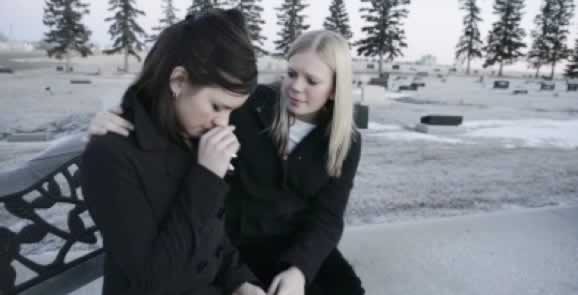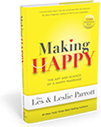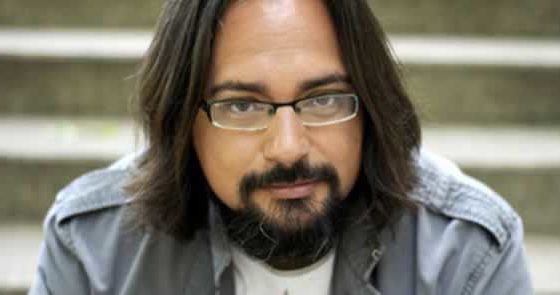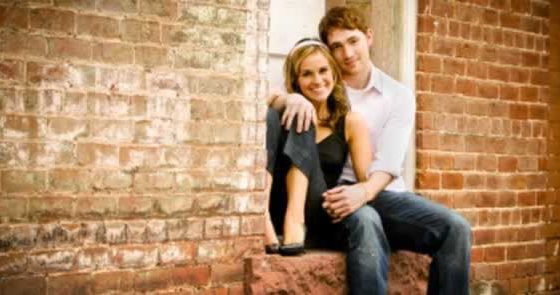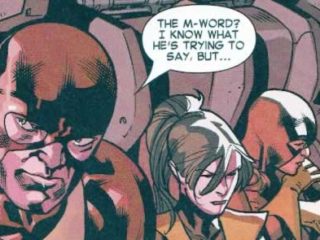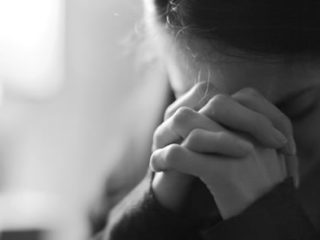Life would be easier, wouldn’t it, if all of its pieces held together. If they always made sense. If nothing ever broke off. If no part were ever lost or twisted or detached.
Imagine life if you could glide smoothly through the day from one of your roles to the next: mother to wife to co-manager to next-door neighbor to aunt to friend; or brother to supervisor to dad to son to church leader. Is there one person in there somewhere? Is it possible to live as the same person at home as at work, instead of civil Jekyll in public and monster Hyde when you’re alone?
Imagine life if no one ever left, if illness never caused loved ones to drop from our lives, if the people we care about never died or deserted us.
Imagine life in Paradise. Eden was the wonderful opening chord of life, a complete harmony. Nothing in excess, nothing missing, nothing broken. But when that break did happen (and what an awful shattering sound it made), when human beings said, “We think we can do this on our own,” all of creation shuddered and cracks spread throughout. Our only hope from then on was that someone, somewhere, would help us put the pieces back together.
But even when things aren’t broken, life often seems to be a pile of pieces we stand looking at, wondering how they all fit together, or if they do. Does what I believe about God have anything to do with how I behave as a citizen? How does my understanding of humanity’s purpose fit with my everyday experiences with people in all their glory and shame? How can God be loving and accepting and angry at the same time? How can horrible things happen to people who seem to be no more than innocent bystanders? How does this speck of dust that we call Earth fit in the vast universe? Where is this world heading? What does God want me to do with my life? Does a person’s belief about life after death change the atmosphere in the chapel before a funeral starts?
Death’s Shattering Blow
I was just four years old when my father suddenly died. What I remember is being at my grandfather and grandmother’s house in the country and not returning back home to Chicago for a very long time. How could a four-year-old have handled the scene my mother had to witness? Wheezing and feverish, my father had struggled under the heavy hand of a terrible cold. Feeling a bit better, he decided to walk down to the corner drugstore to pick up some family snapshots that had been processed. Back home, he felt much worse and asked my mother to get him a cup of warm tea. Minutes later she returned to find him slumped in the large, green easy chair, pneumonia having put fluid where air should have passed. And that was that. Twenty-eight years and then, exit.
I don’t remember crying then. One of the reasons is that when my father dropped out of my life like a meteor’s quick flash in a silent winter sky, the light from other people around me kept burning. Amazingly, they helped put the pieces back together, right away. I was blessed (and certainly don’t take it for granted) with a loving mother, and an uncle and two grandparents on my mother’s side with whom I already had a strong bond. And the next six years, during Our Pieces which we lived as a three-generation household, was a time when my bones grew, my attitudes formed, and my view of life developed fairly unclouded, but only because loving adults held together my life, which ad experienced dismemberment.
Seven or eight years after that, however, I began to see that God the Creator, whom I had believed in but had not really sensed as the powerfully present Father, was really the one putting the pieces back together.
God is Alive and Active
What a startling awakening it is to find that God is alive and active and that he moves powerfully, sometimes as imperceptibly as the stars but as quickly as a cougar when he wants to.
It’s amazing to feel that someone has taken scales off your eyes and, like the blind man Jesus healed, you can see people standing where there were none before (though they may look like trees while your eyes are getting used to the light). And then you discover other people whose eyes have been similarly opened. You find this bond between yourself and others — fathers all about, and mothers and brothers and sisters — all still spiritually gangly and flawed, as human beings always will be, but coming together nonetheless. You find brokenness that you had never noticed before, because the light is helping you see pieces you didn’t even know were there. It may sting a bit to see that there are more pieces than you thought, but the Father’s presence assures you it’s okay.It really will be okay.
All Things Hold Together in Christ
When the Bible says that “in him [that is, Christ], all things hold together,” it is describing the fundamental structure of all reality. “All things” means all things. Go down to the level of the molecule, then the individual atom, and science will tell you it is a mystery how atoms and their particles hold together. But they do. How is it that when you put into your mouth meat and potatoes and vegetables, they break apart but you yourself don’t break apart? Your body keeps fe reorganizing itself, growing, healing. The biological pieces keep coming together, with some interruptions for illness, until that last breath moves out across your lips and the spirit departs. Only then does your body return to dust.
The divine Christ puts the pieces back together because he put it all together the first time. “He is the image of the invisible God, the firstborn over all creation. For by him all things were created: things in heaven and on earth, visible and invisible, whether thrones or powers or rulers or authorities; all things were created by him and for him. He is before all things, and in him all things hold together” (Col. 1:15?17, italics mine).
Our only hope of surviving in a broken, disconnected, fractured world is that God created everything according to a grand pattern. The very meaning of the word creation is taking pieces and making a whole. Heaven and earth do fit together, even though it often seems as if they are two different universes. God created the visible and the invisible as one reality, though we so often choose to live merely as bodies without souls. Why, at creation, did it all hold together? Why are there patterns to the pieces? It is because “all things were created by him and for him” (italics mine).
Tracing Life’s Pieces Back to God and His Pusposes
When we relate the pieces of life back to God as source and believe that the pieces are there for him and his purposes, we can see the sense in it all.
Regarding the human race, broken into so many pieces, that same passage goes on to say, “[Christ] is the head of the body, the church; he is the beginning and the firstborn from among the dead, so that in everything he might have the supremacy. For God was pleased to have all his fullness dwell in him, and through him to reconcile to himself all things, whether things on earth or things in heaven, by making peace through his blood, shed on the cross” (Col. 1:18?20, italics mine).
When one head coordinates and directs a small human community, all the pieces of a new society and a new family — real human 18 Part 1: Our Pieces beings — should come together. And they do come together because Christ’s reconciliation, peace, and blood are real. At the moment of Jesus’ crucifixion, when it seemed as if the whole world were falling apart, when he who is good and right was resolutely rejected, humiliated, and then murdered, the reconstruction began. The earth shook and rocks split, and in the temple, the curtain was torn in two from top to bottom, signifying that the division between God and humanity was coming down, that a new way was opening for earth to rejoin heaven.
Are you looking to start foundational construction or make repairs in your life? Those are the two basic ideas in this book: putting pieces together and putting pieces back together. One person in a courtship attempts to fit the pieces together to make a marriage; another attempts to fix a broken marriage. Fit and fix. Pieces put together and pieces put back together. Someone in the first week of a job tries to navigate new territory; someone else has been twenty years on the job and that same week attempts to repair a problem to avoid getting fired. A new believer reads the gospel of John for the first time, fitting Jesus’ statements there with other passages about Jesus; a longtime believer shuffles through well-worn pages, scanning for a passage that may build up a discouraged friend. A college freshman is confronted for the first time in philosophy class with the problem of evil; a policeman stands at the scene of a sniper shooting, shaking his head in dismay.
Building the House of Faith
Our whole lives, we are in the process of building the house of our personal faith and understanding, a house we can seek shelter in when some random hurricane hits. Life would be great if all of it were constructive, if we never had to fix anything. But that’s not the way it is; we must build and we must repair. If a person hasn’t built something in the first place, it is hard to find shelter when the storms hit.
Years ago I spoke at a shelter for homeless people. A large man in drooping and dark clothes, once a university professor but now a street dweller, sat and played beautifully at the piano. A young man in a dirty yellow jacket sat in a chair against the wall, staring straight ahead. I stepped up to an oak lectern as old men and young men shuffled along the tiled floor to take their seats. I have never been homeless, so I cannot imagine what it must be like to be naked in the world that way. What words would I share with them? This was no day for spiritual cliché³ or pious platitudes. These men had nothing. The food in their stomachs was a bonus for the day. Some may have wanted to hear words of spiritual truth; others likely did not.
Putting the pieces of personal faith together and building that faith is like finding a home to live in after you have been homeless. You gain a roof over your head to protect you from the elements. Walls set boundaries for the various parts of living. There are places where food and clothes, pots and pans, furniture and linens are organized and stored.
God wants each of us to have a belief system that is not merely a collection of bits and pieces of opinion and conviction. Faith is a great pattern in which specific beliefs fit together in a God-defined design. Like a house constructed from foundation blocks, beams, bricks, and roofing tiles, a personal Christian belief system should have structural integrity, beauty, and practicality.
And how glad we can be that we do not need to make this design. We discover it. Truth is not something we invent. Its attractiveness flows directly from the exquisite personality of God. Its consistency comes from the unchanging character of God. And its practicality comes from the gracious desire of God to give us a home we can live in.
So if you believe in God, the Father Almighty, who made heaven and earth; if you believe in Jesus Christ, God’s Son who came to earth; if you believe in the Holy Spirit; and if you believe that we are designed to live as a communion of saints, that forgiveness is the fresh beginning offered by a merciful God, and that there is an everlasting life beyond this Act One of our existence — then you have the foundations of a home you can live in.
And the best thing you can do is to say to God, “Where, dear Lord, do you want to continue the construction of my faith today?”
Pray This
Lord, help me to sort the pieces of my life. I want to have a faith that is certain because it holds together and consistent because it is part of the tapestry of your truth. I want to be a consistent person in all the different roles I have to play in life. I know I need your help with the tremors that have shaken me in the past and that will do so again in the future.
Copyright © 2005 Mel Lawrenz, Used by Permission. Published by Zondervan.

